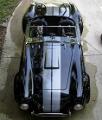Hey guys,
I thought Id' break this out into it's own thread. Who here has experience hooking the speedhut gauges into the Ron Francis wiring harness? My gauge harness was made for the Autolights and I don't know how (or if) to wire the sensors and gauges into the harness. For example, how does the fan work if speedhut is using the sensor for water temp? How does the Ron Francis harness tell how hot the coolent is to actuate the fan?
How do you integrate the fuel level?
Stuff like that. I need help!

- Home
- Latest Posts!
- Forums
- Blogs
- Vendors
- Forms
-
Links

- Welcomes and Introductions
- Roadster
- Type 65 Coupe
- 33 Hot Rod
- GTM Supercar
- 818
- Challenge Series
- 289 USRCC
- Coyote R&D
- Ask a Factory Five Tech
- Tech Updates
- General Discussions
- Off Topic Discussions
- Eastern Region
- Central Region
- Mountain Region
- Pacific Region
- Canadian Discussions
- Want to buy
- For Sale
- Pay it forward
-
Gallery

- Wiki-Build-Tech


 Thanks:
Thanks:  Likes:
Likes: 


 Reply With Quote
Reply With Quote








